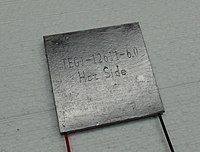
Photo from wikipedia
An infrared detector with high responsivity based on graphene–PbSe thin film heterojunction was reported. High-quality PbSe thin film and graphene were prepared by molecular beam epitaxy and chemical vapor deposition,… Click to show full abstract
An infrared detector with high responsivity based on graphene–PbSe thin film heterojunction was reported. High-quality PbSe thin film and graphene were prepared by molecular beam epitaxy and chemical vapor deposition, respectively. The physical characteristics of PbSe thin film and graphene were performed using X-ray diffraction (XRD), X-ray photoelectron spectroscopy (XPS) and Raman measurement. The phototransistor using PbSe thin film as a sensitizer and graphene as a channel to transport excitons exhibits peak responsivity and detectivity up to ~ 420 A·W −1 and 5.9 × 10 11 Jones (radiation intensity: 0.75 mW·cm −2 ) at room temperature in the near-infrared (NIR) region, respectively. The high optical response is attributed to the photo-excited holes transferring from PbSe film to graphene under irradiation. Moreover, it is revealed that the responsivity of graphene–PbSe phototransistor is gate-tunable which is important in photodetectors.
Journal Title: Rare Metals
Year Published: 2019
Link to full text (if available)
Share on Social Media: Sign Up to like & get
recommendations!